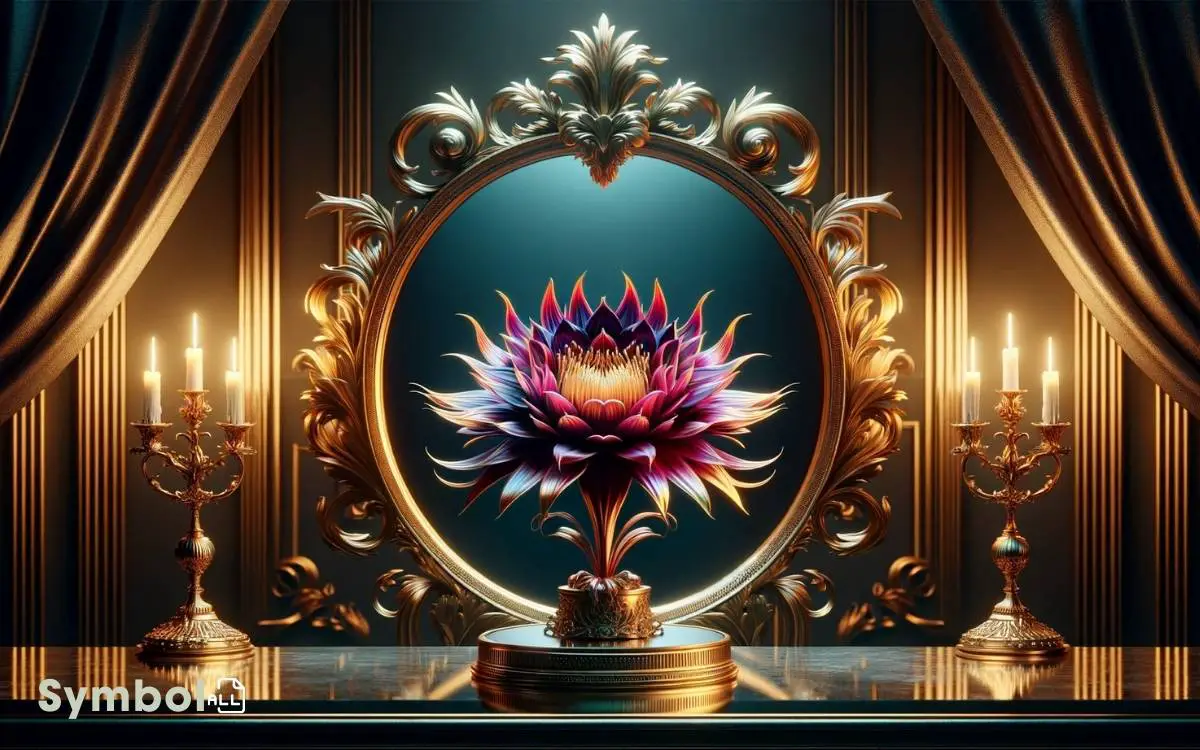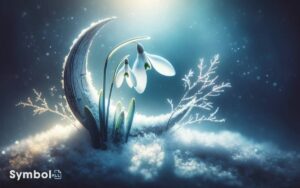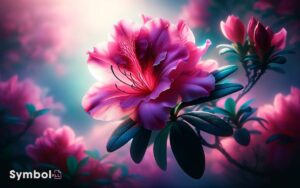Which Flower Is a Symbol of Vanity? Narcissus Flower!
You’re looking at the Narcissus flower as the prime symbol of vanity. Immersed in Greek mythology, this flower mirrors the tragic tale of Narcissus, who became consumed by his reflection.
Your interest in the Narcissus isn’t just about its enchanting beauty; it’s about understanding the depth of its symbolism, linking it to self-obsession and, by extension, narcissistic personality traits.
Varieties like the Trumpet or Jonquilla embody not just vanity but also resilience and rebirth. As societal values evolve, so does the Narcissus’s relevance, reflecting on beauty and self-admiration amidst nature’s cycles.
Your curiosity will reveal a deeper grasp of how flora like the Narcissus articulates complex human emotions and societal values.

Key Takeaways
The Legend of Narcissus
In analyzing the legend of Narcissus, one finds a compelling study of self-obsession and its consequences, rooted deeply in Greek mythology. You’ll discover that this narrative serves as a cautionary tale, illustrating the dangers of excessive self-love and the neglect of others.
Scientifically, this obsession can be seen as a metaphor for echoism, a personality trait characterized by an extreme lack of self-esteem.
Through detailed examination, it’s evident that Narcissus’s inability to connect with anyone beyond his reflection suggests a deep-seated narcissistic personality disorder.
This condition, named after the myth itself, highlights a detachment from reality and an excessive focus on oneself.
Analytically, the legend examines the psychological ramifications of such behavior, offering a timeless warning against the perils of vanity and self-absorption.
Narcissus in Mythology
You must consider the myth origin of Narcissus to fully grasp its symbolic meanings in various cultures. This narrative not only provides context but also reveals the complex interplay between beauty, vanity, and self-obsession as reflected in the natural world.
Analyzing this myth through a scientific lens allows for a nuanced understanding of how symbolism evolves over time and impacts cultural interpretations.
Myth Origin
The myth of Narcissus, central to understanding the symbol of the narcissus flower, tells the tale of a young man’s tragic vanity and self-obsession.
According to ancient sources, Narcissus was a figure of extraordinary beauty and allure, yet he possessed an inability to love anyone other than himself.
This narrative unfolds with Narcissus encountering his own reflection in a pool of water, falling hopelessly in love with it, and ultimately perishing because of his unattainable desire.
This myth, originating from Greco-Roman mythology, offers a profound examination of self-admiration pushed to the extreme.
It meticulously analyzes the psychological dynamics of Narcissus’s fixation with his image, setting a precedent for interpreting vanity and self-obsession within a mythological and cultural context.
Symbolic Meanings
Delving into the symbolism of the narcissus within mythology reveals how this flower embodies the complex themes of beauty, vanity, and self-reflection.
In ancient tales, particularly the Greek myth of Narcissus, this bloom isn’t merely a plant but a profound emblem of the dangers of excessive self-admiration.
You’ll find that the story illustrates Narcissus, so captivated by his own reflection, he transforms into the very flower that now bears his name, symbolizing eternal beauty frozen in time.
Scientifically analyzing this transformation, it’s evident that the myth conveys a cautionary tale about the importance of looking beyond surface appearances.
The narcissus, with its head bowed as if in contemplation, serves as a living reminder of the balance between self-awareness and vanity, urging you to reflect on the depth beyond the reflective surface.
Symbolism of the Daffodil
Daffodils symbolize rebirth and new beginnings, embodying the arrival of spring with their vibrant blooms. This symbolism originates from their growth cycle, as they’re among the first flowers to emerge from the thawing ground in early spring.
Their bright yellow hues are scientifically linked to the concept of essential and the sun’s life-giving energy, contributing to their association with renewal and the promise of brighter days.
From a botanical perspective, daffodils’ perennial nature reinforces this symbolism, as they return year after year, illustrating the cycle of life and nature’s resilience.
This makes them not just a herald of spring, but a powerful symbol of the ability to overcome adversity, embodying hope and persistence in the face of challenges.
Varieties of Narcissus
As you explore the different types of Narcissus, it’s essential to comprehend their unique characteristics and classifications.
Examining cultivation tips guarantees you’re equipped with the necessary knowledge for best growth and care.
Recognizing common Narcissus varieties not only enriches your botanical understanding but also enhances your ability to apply this knowledge practically.
Common Narcissus Types
Exploring the diverse world of Narcissus, you’ll find that this genus encompasses a multitude of varieties, each with distinct characteristics and ecological preferences.
Among the most common types, the Trumpet Narcissus stands out for its large, solitary flowers with a long, trumpet-like corona, thriving in well-drained soils.
Conversely, the Tazetta Narcissus, known for clusters of small, fragrant blooms, adapts well to warmer climates.
Another notable variety, the Jonquilla Narcissus, features multiple small flowers per stem, exuding a sweet scent and preferring sunnier locations.
Analyzing these types reveals adaptations that safeguard survival and reproduction across diverse habitats, from full sun to partial shade, indicating a remarkable evolutionary strategy within the genus Narcissus to exploit a wide range of ecological niches.
Cultivation Tips
Understanding the specific needs of Narcissus varieties is essential for successful cultivation, as each exhibits unique preferences for soil, light, and water conditions.
Narcissus plants, commonly known as daffodils, thrive in well-drained, slightly acidic to neutral soil. They require ample sunlight to bloom profusely but can tolerate partial shade.
Regular watering during the growing season is vital, yet the soil must not become waterlogged to prevent bulb rot.
| Variety | Preferred Conditions |
|---|---|
| Trumpet | Full sun, well-drained soil |
| Jonquil | Light shade, moderately fertile soil |
| Tazetta | Bright, indirect light, rich soil |
Each variety’s adaptation to its environment underscores the importance of meticulous research and preparation in horticulture, ensuring not just survival but flourishing growth and vibrant blooms.
Cultural Significance
Flowers hold deep cultural significance, often embodying complex societal values and beliefs across different civilizations. Throughout history, specific flowers have been associated with particular traits, including vanity.
This association isn’t arbitrary but rooted in the flower’s characteristics, such as its appearance, rarity, or the conditions under which it thrives. Analyzing these associations provides insight into how different cultures perceive and value traits like beauty and self-admiration.
For instance, a flower considered a symbol of vanity might possess an exceptionally enchanting appearance, mesmerizing observers and drawing parallels to the human trait of desiring admiration.
Its cultivation might require meticulous care, mirroring the effort one puts into maintaining a vanity-driven image.
Understanding these cultural significances allows you to appreciate the depth of meaning behind floral symbols in various societies.
The Language of Flowers
You’ll find that the language of flowers, with its intricate origins and meanings, offers a unique method for expressing emotions without words.
This system, evolving through centuries, allows for the silent communication of sentiments, ranging from love to grief, based on the type and color of the flower chosen.
In contemporary contexts, these interpretations have adapted, reflecting changes in societal values and communication methods.
Origins and Meanings
Delving into the origins and meanings of the language of flowers reveals a complex web of cultural, historical, and botanical intricacies.
This symbolic language, known as floriography, emerged prominently in the Victorian era but draws on much older traditions from various civilizations, including the ancient Greeks, Egyptians, and Chinese.
Each flower and its color were attributed specific meanings, transforming simple bouquets into nuanced messages.
Scientifically, the study of plant symbolism requires understanding botany, the cultural significance of colors, and historical context. For instance, a red rose universally symbolizes love, but its meaning can shift subtly with variations in hue or accompanying flowers.
This intricate system allowed individuals to express sentiments in a society where direct expression was often constrained.
Expressing Emotions Silently
In a world where words often fall short, the language of flowers provides an intricate method for individuals to convey complex emotions silently and with precision.
This botanical lexicon allows you to:
- Express Affection: Red roses symbolize deep love and desire, enabling you to communicate intense feelings without uttering a single word.
- Convey Sympathy: Lilies, with their serene beauty, are often used to express condolences, offering comfort in times of loss.
- Demonstrate Respect and Admiration: The gladiolus, with its striking presence, is chosen to show admiration and respect, highlighting the virtues of integrity and moral strength.
Each flower carries a specific meaning, contributing to a nuanced language that transcends verbal communication. This system is predicated on a historical framework, evolving from cultural practices and symbolisms associated with flora.
Modern Interpretations
How does the evolving landscape of cultural norms and digital communication reshape the ancient language of flowers in contemporary society?
You’re witnessing a revival and transformation where flowers’ symbolic meanings adapt to modern contexts.
The digital age amplifies this evolution, as social media platforms become new gardens where these symbols flourish and mutate.
Scientifically, this shift is analyzed through semiotics, the study of signs and symbols.
Researchers scrutinize how digital interactions reinterpret floral symbolism, noting a trend towards personalization and irony.
For instance, the peony, traditionally a symbol of bashfulness, now frequently represents opulence and social status in online exchanges.
This modern interpretation aligns with current societal values, illustrating the dynamic relationship between cultural symbols and collective identity.
Narcissus in Art and Literature
The Narcissus flower, often depicted in art and literature, symbolizes vanity and self-obsession, reflecting its mythological origins.
In your explorations, you’ll discover its emblematic presence across various mediums, illustrating not only its beauty but also its cautionary tale.
- Paintings: Artists have historically used the Narcissus to embody themes of egotism and the fleeting nature of beauty, meticulously capturing its delicate form.
- Poetry: Poets weave the Narcissus into narratives as a metaphor for self-admiration and its destructive potential, employing vivid imagery to convey their message.
- Mythological References: The flower’s mythological roots are frequently explored, highlighting the tragic story of Narcissus, whose obsession with his reflection leads to his demise.
These manifestations underscore the Narcissus’s complex symbolism, inviting a deeper appreciation of its role in art and literature.
Growing and Caring for Narcissus
Shifting from its symbolic representation to practical horticulture, you’ll find growing Narcissus requires understanding their specific needs, including well-drained soil and ample sunlight.
These bulbs thrive in zones 3-9, indicating a wide climate adaptability but they demand precise conditions.
Plant them in early fall, positioning bulbs at least 3 inches deep and 3-6 inches apart to guarantee adequate room for root development.
A key aspect is making sure the soil is fertile, slightly acidic to neutral (pH 6-7), and maintains moisture without waterlogging. Incorporating organic matter enhances soil structure, promoting healthier growth.
During the growing season, consistent watering supports their lifecycle, yet it’s essential to reduce frequency post-bloom to prevent bulb rot. Understanding these agronomic practices optimizes Narcissus vitality, showcasing its beauty beyond mere symbolism.
Narcissus in Modern Culture
Often, Narcissus flowers infiltrate modern culture, serving as multifaceted symbols in literature, art, and psychology that reflect complex human emotions and societal values.
- Literature: The Narcissus frequently appears as a motif representing self-absorption and the peril of excessive self-love, subtly critiquing characters’ moral failures or tragic flaws.
- Art: Artists use the Narcissus to convey messages about beauty and its transient nature, often juxtaposing its delicate appearance with darker themes of vanity and ephemeral life.
- Psychology: The term ‘narcissism’ itself, derived from the myth of Narcissus, has evolved in psychological discourse to describe a spectrum of self-focused behavior, from healthy self-esteem to pathological self-absorption, illustrating the flower’s deep-rooted influence in understanding human behavior.
These dimensions underscore the Narcissus’s enduring symbolic resonance across various facets of modern culture.
Self-Love Vs. Narcissism
Exploring the fine line between self-love and narcissism reveals a nuanced understanding of their impact on individual psychology and societal interactions.
Self-love constitutes a healthy regard for one’s well-being and happiness, fostering self-compassion and resilience against life’s adversities. It’s grounded in reality, acknowledging both strengths and weaknesses.
Narcissism, in contrast, is characterized by an inflated sense of self-importance, a deep need for excessive attention and admiration, and a lack of empathy for others.
While self-love encourages personal growth and empathic relationships, narcissism often leads to interpersonal conflicts and a diminished capacity for genuine connections.
Understanding this differentiation is vital for fostering healthy self-perception and maneuvering social dynamics effectively.
Other Flowers and Their Meanings
Beyond the domain of self-perception, numerous flowers carry specific meanings that have been analyzed and interpreted across cultures and historical periods.
These meanings not only reflect the aesthetic beauty of the flowers but also convey complex emotions, ideas, and social messages. These symbolic associations allow people to communicate sentiments that words alone often cannot express, making flowers powerful instruments of emotional and cultural connection. For instance, a flower that symbolizes eternal love might be given to a partner to represent enduring commitment and affection that transcends time. Through such gestures, the language of flowers continues to serve as a timeless medium for expressing the deepest of human emotions.
Here’s a closer look at some examples:
- Roses: Symbolize love, passion, and admiration. The color of the rose further refines its meaning, with red roses representing deep love and white roses denoting purity.
- Lilies: Often associated with purity and renewal, lilies are a common symbol in funerary traditions, representing the soul’s return to a peaceful state.
- Sunflowers: Stand for adoration, loyalty, and longevity. Their tendency to turn towards the sun symbolizes seeking out positivity and strength.
These symbols offer a nuanced language for expressing complex human emotions and ideas through the medium of flora.
The Darker Side of Beauty
While many flowers symbolize positive attributes, it’s important to recognize that they also embody more complex, sometimes darker meanings that reflect aspects of human nature and societal norms. This duality serves as a metaphor for the multifaceted nature of beauty itself.
It’s not just external appearances that are valued but the underlying layers of meaning and interpretation that they carry.
For instance, a flower’s aesthetic appeal may draw you in, but its association with vanity or fleeting beauty prompts a deeper reflection on the impermanence of physical attractiveness and the societal pressure to conform to certain beauty standards.
Analyzing these symbolisms provides insight into how beauty is perceived and valued, highlighting the subjective and often transient nature of what’s considered beautiful.
Reflections on Vanity and Nature
In the domain of nature, vanity isn’t merely a human construct but manifests intricately through the lifecycle and behaviors of various flora, prompting us to reconsider our perceptions of natural beauty and its ephemeral qualities.
Consider these elements:
- Mutualism and Competition: Plants engage in a delicate dance of mutualism and competition, showcasing their most vibrant blooms to attract pollinators, a clear display of vanity in the natural world.
- Seasonal Variations: The cyclic blooming and withering of flowers reflect the transient nature of beauty, emphasizing the vanity of clinging to ephemeral appearances.
- Adaptive Signaling: Flowers evolve elaborate colors and patterns to signal their readiness to pollinators, an adaptive mechanism that parallels human expressions of vanity.
Understanding these dynamics enriches your appreciation for the complexity and depth of natural systems, challenging simplistic views of vanity.
Conclusion
Just as Icarus flew too close to the sun, the story of the narcissus warns us of the peril in excessive self-admiration. This flower, embodying both beauty and a cautionary tale, serves as a complex symbol in nature’s lexicon.
Its diverse varieties and cultural significance underscore the fine line between self-love and vanity. Through understanding the narcissus, we gain insights into the darker shades of beauty and are reminded to tread carefully on the path of self-reflection.






